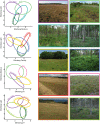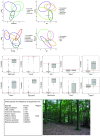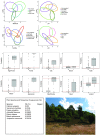Predicting provenance of forensic soil samples: Linking soil to ecological habitats by metabarcoding and supervised classification
- PMID: 31283764
- PMCID: PMC6613677
- DOI: 10.1371/journal.pone.0202844
Predicting provenance of forensic soil samples: Linking soil to ecological habitats by metabarcoding and supervised classification
Abstract
Environmental DNA (eDNA) is increasingly applied in ecological studies, including studies with the primary purpose of criminal investigation, in which eDNA from soil can be used to pair samples or reveal sample provenance. We collected soil eDNA samples as part of a large national biodiversity research project across 130 sites in Denmark. We investigated the potential for soil eDNA metabarcoding in predicting provenance in terms of environmental conditions, habitat type and geographic regions. We used linear regression for predicting environmental gradients of light, soil moisture, pH and nutrient status (represented by Ellenberg Indicator Values, EIVs) and Quadratic Discriminant Analysis (QDA) to predict habitat type and geographic region. eDNA data performed relatively well as a predictor of environmental gradients (R2 > 0.81). Its ability to discriminate between habitat types was variable, with high accuracy for certain forest types and low accuracy for heathland, which was poorly predicted. Geographic region was also less accurately predicted by eDNA. We demonstrated the application of provenance prediction in forensic science by evaluating and discussing two mock crime scenes. Here, we listed the plant species from annotated sequences, which can further aid in identifying the likely habitat or, in case of rare species, a geographic region. Predictions of environmental gradients and habitat types together give an overall accurate description of a crime scene, but care should be taken when interpreting annotated sequences, e.g. due to erroneous assignments in GenBank. Our approach demonstrates that important habitat properties can be derived from soil eDNA, and exemplifies a range of potential applications of eDNA in forensic ecology.
Conflict of interest statement
The authors have declared that no competing interests exist.
Figures



Similar articles
-
Environmental DNA metabarcoding: Transforming how we survey animal and plant communities.Mol Ecol. 2017 Nov;26(21):5872-5895. doi: 10.1111/mec.14350. Epub 2017 Oct 26. Mol Ecol. 2017. PMID: 28921802 Review.
-
Massively parallel sequencing is unlocking the potential of environmental trace evidence.Forensic Sci Int Genet. 2021 Jan;50:102393. doi: 10.1016/j.fsigen.2020.102393. Epub 2020 Sep 16. Forensic Sci Int Genet. 2021. PMID: 33157385 Review.
-
Utilizing eDNA from bacteria, fungi, plants, and arthropods associated with mock geologic evidence for sample-to-sample comparisons and study site separation: A feasibility study.Forensic Sci Int Genet. 2025 Jun;78:103284. doi: 10.1016/j.fsigen.2025.103284. Epub 2025 Apr 12. Forensic Sci Int Genet. 2025. PMID: 40253925
-
Geographic source estimation using airborne plant environmental DNA in dust.Sci Rep. 2021 Aug 10;11(1):16238. doi: 10.1038/s41598-021-95702-3. Sci Rep. 2021. PMID: 34376726 Free PMC article.
-
Taxonomic accuracy and complementarity between bulk and eDNA metabarcoding provides an alternative to morphology for biological assessment of freshwater macroinvertebrates.Sci Total Environ. 2024 Jul 20;935:173243. doi: 10.1016/j.scitotenv.2024.173243. Epub 2024 May 16. Sci Total Environ. 2024. PMID: 38761946
Cited by
-
Microbiomes in forensic botany: a review.Forensic Sci Med Pathol. 2021 Jun;17(2):297-307. doi: 10.1007/s12024-021-00362-4. Epub 2021 Apr 8. Forensic Sci Med Pathol. 2021. PMID: 33830453 Review.
-
Scrub encroachment promotes biodiversity in temperate European wetlands under eutrophic conditions.Ecol Evol. 2022 Nov 1;12(11):e9445. doi: 10.1002/ece3.9445. eCollection 2022 Nov. Ecol Evol. 2022. PMID: 36340817 Free PMC article.
-
Environmental DNA as an innovative technique to identify the origins of falsified antimalarial tablets-a pilot study of the pharmabiome.Sci Rep. 2022 Dec 20;12(1):21997. doi: 10.1038/s41598-022-25196-0. Sci Rep. 2022. PMID: 36539480 Free PMC article.
-
Optimization of the second internal transcribed spacer (ITS2) for characterizing land plants from soil.PLoS One. 2020 Apr 16;15(4):e0231436. doi: 10.1371/journal.pone.0231436. eCollection 2020. PLoS One. 2020. PMID: 32298321 Free PMC article.
-
Environmental DNA and RNA as Records of Human Exposome, Including Biotic/Abiotic Exposures and Its Implications in the Assessment of the Role of Environment in Chronic Diseases.Int J Mol Sci. 2020 Jul 10;21(14):4879. doi: 10.3390/ijms21144879. Int J Mol Sci. 2020. PMID: 32664313 Free PMC article. Review.
References
-
- Devictor V, van Swaay C, Brereton T, Brotons L, Chamberlain D, Heliölä J, et al. Differences in the climatic debts of birds and butterflies at a continental scale. Nature Climate Change. 2012;2:121 10.1038/nclimate1347 https://www.nature.com/articles/nclimate1347#supplementary-information. - DOI
-
- Parmesan C, Yohe G. A globally coherent fingerprint of climate change impacts across natural systems. Nature. 2003;421:37 10.1038/nature01286 https://www.nature.com/articles/nature01286#supplementary-information. - DOI - PubMed
-
- Wiltshire PE. Forensic ecology, botany, and palynology: some aspects of their role in criminal investigation Criminal and environmental soil forensics: Springer; 2009. p. 129–49.
Publication types
MeSH terms
Substances
LinkOut - more resources
Full Text Sources

